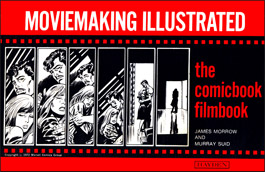In the 1930s, long before MTV, Disney’s “Silly Symphonies” and “Fantasia” explored the relationship between music and moviemaking. Simon Presto’s “Waiting for the Ferryman” carries on that tradition, and extends it to the documentary genre. In the following interview, this UK-based filmmaker discusses the techniques he used in making his short film.
MMM: Do you see “Waiting for the Ferryman” primarily as a music video or as a documentary?
SIMON: It’s both, although initially I wanted it to illustrate and facilitate the complex rhythms in the music that it accompanies. Even though the footage of the people is inherently mundane, I thought it was interesting to capture this melting pot of Swahili Coast culture with its variety, searing 40 degree heat, colour and spirit of openness. It seemed natural to marry it with the music which had been directly inspired by that same ancient coastal trading culture – a juxtapositioning of ancient and modern , music and visual.
MMM: What gave you the idea to use a variety of visual effects in dealing with the subject? Were you inspired by another film or filmmaker?
SIMON: No effects except the speed variations which were designed to enhance both the music’s rhythms and the routineness of the journey the film’s subjects were making.
MMM: Could you say something about your use of still or frozen images?
SIMON: The use of the stills within the context of a fast moving continuous tracking shot adds a poignancy to the fast sequence of images. Often they are people ‘hidden’ within the sped up or fast-moving tracking shot who are suddenly and momentarily revealed by this ‘still’ which is punctuated by or punctuates the music score. The length of the ‘still’ only needs to be a second or less otherwise it becomes too laboured for the eye. Its subliminalness is a strength especially when married to the music.
MMM: What about your use of reverse motion?
SIMON: The use of the reverse motion or ‘to and fro’ technique transforms the mundane movements of the market traders into a dance and invites us into the subjects’ micro world whilst enhancing the music (and vice versa). Once the ‘dance ‘ is over and the video continue to move forward, it feels like a pleasant release of tension.
MMM: Why did you decide to shoot using a smartphone rather than a conventional camera? (Our site is all about using smartphones, tablets, and GoPros, and we like to provide reasons for using mobile devices.)
SIMON: No other device available. The rectangular flat nature of the phone was ideal in that I could hold it tight against the window of the vehicle I was in especially on roads that often have large potholes and rock the vehicle as it moves. The lo-fi quality of the phone camera when picking out the still frames can add an ephemeral, fragile and transitory quality to the images and their apparent meaning… the man staring out to sea at 4:15 and the boy walking a second later have seemingly been imbued with a poignant, timeless and otherworldly quality. As if they have been plucked out like a shard of memory from the superfast passage of time and experience.
MMM: Did the people whom you filmed know that you were shooting? Did anyone object?
SIMON: The young man at 1:04 we actually knew which is why he is smiling. Actually it’s very hard to film people behaving naturally in Tanzania generally when you are not in a direct relationship with them or have a context despite the fact most people now to seem to own a mobile in Tanzania. Although I did directly film people in Dar es Salaam, it was when I had a role or reason to be there. I wanted to capture the natural passing-by and unaffected activity of the people as they walked towardsthe ferry crossing.
MMM: How did you get the more candid shots?
SIMON: I did this by holding the mobile phone to the car window for many hours capturing those times when the vehicle moved along the traffic jam in conjunction with the people walking alongside. This led to some excellent unplanned coincidences as when the schoolgirl walks to the right having bought a drink just as the vehicle moves with her. Not only did the car window pane give me a frame and a ready-made ‘steady cam’ so to speak, it also gave me some great tracking shots which are doubly effective when synchronised with the music.
MMM: Any other tricks for capturing people as they are–without posing?
SIMON: In Africa, I have found that one of the best opportunities for me to point and film directly at people without causing consternation, demands for money or any other unnatural behaviour is when I am actually playing live music myself directly to and in front of them.
MMM: What software did you use to edit the movie?
SIMON: All edited in iMovie.
MMM: Did you encounter any big problem in making this movie? If yes, how did you deal with it?
SIMON: Yes, when I tried filming a large crowd of people getting off the ferry, the officials came over and tried to arrest me although it transpired that they were really after a nice big ‘fine’ i.e. bribe as, being a Sunday, there was no ‘manager’ to sign a receipt.
MMM: What is your training in filmmaking. Did you go to film school or read books or learn by trial and error.
SIMON: The latter; in fact this is one of my first attempts.
MMM: Do you have any advice for beginning filmmakers who would like to shoot movies of the sort that you’re making?
SIMON: Apart from having a good idea, work out how to keep the device stable and build up a big library of shots. Lighting is critical and in this case being just south of the equator meant the sun was directly overhead giving superb light .
MMM: If you’re working on a new project, can you give us a hint about it?
SIMON: Yes, I have 3 or 4 other Tanzanian videos I am working on which involve dance and one addressing the migrants’ story.
MMM: What’s the best way for people to keep up with your work?
SIMON:They can follow my work on YouTube https://www.youtube.com/watch?v=RTNEiOLGXW8 and Facebook https://www.facebook.com/simon.presto



 Previous post
Previous post
 Next post
Next post





